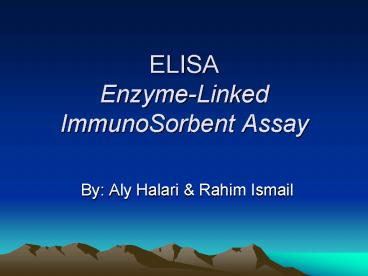ELISA EnzymeLinked ImmunoSorbent Assay - PowerPoint PPT Presentation
1 / 22
Title:
ELISA EnzymeLinked ImmunoSorbent Assay
Description:
Used in diagnosing the concentration of a variety of specific proteins and ... Ig's are immunogenic when used to immunize individuals of another species. ... – PowerPoint PPT presentation
Number of Views:930
Avg rating:3.0/5.0
Title: ELISA EnzymeLinked ImmunoSorbent Assay
1
ELISAEnzyme-Linked ImmunoSorbent Assay
- By Aly Halari Rahim Ismail
2
What is ELISA?
- A biochemical technique, used to determine if a
particular protein is present in a sample. - Used in diagnosing the concentration of a variety
of specific proteins and antibodies in solution,
for example HIV - Detection can involve determining levels of
either antibodies or antigens.
R
3
Procedure
Obtain a pure sample of the desired antigen or
antibody to standardize the assay. The first
method we will discuss is called and indirect
ELIZA which utilizes a purified antigen. It is
used to determine the amount of a particular
antibody in a given unknown sample
R
4
In an indirect ELIZA, the antigen, is attached to
a solid support, such as the bottom of a plastic
multi-well plate, where it adsorbs the protein
(1). Following blocking of non-specific sites,
the test sample containing the unknown serum is
added (2). Serum addition is such that the
antigen (1) is always in excess. Following
incubation, plates are washed (to remove unbound
factors), and a secondary antibody is added (3)
which contains a bound enzyme (4). Following
removal of unbound secondary antisera, a enzyme
substrate is added (5). Reaction of the substrate
with the enzyme produced a colored product which
is quantitated using a spectrophotometer.
R
5
- A basic step in all ELIZAs is binding increasing
concentrations of the known reagent. The response
observed in subsequent wells allows the user to
determine a standard response curve for each
particular assay over a given concentration
range. By doing so, the user can be confident in
how much unknown there is in a particular sample.
The stronger the signal, the less unknown antigen
is present in the sample
A
6
Requirements for ELISA
- At least one of the reagents (antigen or
antibody) must be available in a purified form. - Bound and unbound reagents must be separated to
determine the percentage of specific binding.
R
7
RIA
- Radioimmunoassay (RIA)
- Similar to ELISA, but the antibody will be
radiolabeled, usually with 125I. - Advantage is the level of sensitivity afforded by
RIA is greater than standard ELIZAs. - But, there are hazards associated with this.
R
8
There are many forms of ELISA
A
9
Capture ELISA
- Also called Sandwich ELISA
- Can be used to detect secreted products like
cytokines. - Antigen-specific antibody is first bound to the
plate. - Following antigen binding, a second (labeled)
antibody is introduced, which binds to a
different epitope on the antigen. This antibody
(shown in red) is linked to the detection
chemistry.
Unknown being studied
Plate
A
10
Notice the similarities between RIA Capture
ELISA, the only difference being in the
identification techniques!
A
11
ELISA tells us the amount or degree to which
something is present. It does not directly
indicate the affinity of that interaction.
A
12
Competitive Inhibition Assay
- Allows you to measure the affinity of an antigen
or antibody interaction. - Antigen in unknown sample is allowed to compete
with a labeled reference antigen to bind with an
antibody that is attached to a plastic well.
A
13
A
14
A
15
A
16
A
17
A
18
Labeled Anti-immunoglobin Antibodies
- Antibodies whose antigen is other antibodies.
- Igs are immunogenic when used to immunize
individuals of another species. - These can be specific for heavy or light chains
of Igs, or for specific isotypes. - E.g. immunization of goats with mouse IgG, and
then can isolate anti-mouse IgG antibodies using
affinity chromotography.
Notice the similarity of this procedure to the
normal ELISA procedure, the difference here being
the antibody binds to a second antibody which is
labelled
A
19
What are the uses of Labeled Anti-immunoglobin
Antibodies?
- Can perform an ELISA assay, but you can detect
bound, unlabeled antibodies with a labeled
antibody specific for that antibody. - This is called a second layer, and the use of
this also amplifies the signal because two
molecules of anti-Ig antibody can bind each
unlabeled antibody. - Advantages are twofold
- You can save on reagent labeling costs by using a
standard labeled anti-Ig antibody - Provides a standard detection system, so results
of different assays can be compared.
A
20
Conclusions
- ELISA is a very versatile assay.
- There are numerous variations of it, each with
their own advantages and disadvantages. - Can be used to detect the presence of a specific
antibody or antigen in a sample, and thus can be
used to detect the presence of certain diseases
in humans, such as HIV.
A
21
Questions?
22
References
- 1) Janeway, C., Shlomchik, M., Travers, P.,
Walport, M. (2005). Immunobiology The Immune
System in Health and Disease. New York Garland
Science Publishing. - 2) ELISA Assay. (2006). The ELISA Assay,
Retrieved January 14, 2008. Website
http//www.elisaassay.com/































